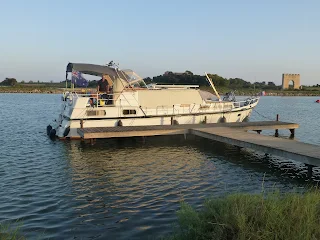 |
| Final locks, Canal du Garonne |
Apologies for the long delay in winding up the blog for the year. We have just arrived back in Australia and these first, foggy days of disorientation are as good a time as any to ponder the past months before looking forward to the summer down-under. The eternal summer of the migrant boater is a hard life. We spent 3 weeks in Scotland en route and so France already seems a slightly hazy memory - or perhaps that's just due to the jet lag.
My last post was from Moissac, a vibrant town with a cathedral, an impressive aqueduct, a large market and a beautiful river. It is possible to lock down onto the river here to moor and cruise a few kilometres which would be lovely during summer. This time we just spent a couple of days in the friendly port.
 |
| River Tarn from the aqueduct Moissac |
 | |
| Moissac |
Our next stop was Valence d'Agen which was a surprisingly pleasant town with 2 market squares close by each other- I don't know why. The little port comprises several finger pontoons with electricity and water. All good until we attempted to leave in the morning only to discover that the water level had dropped considerably overnight and we were aground. Again, I don't know why. Thanks to the help of a crazy French hirer we eventually managed to rock, push, haul ourselves free. I'm embarrassed to say we left our kind helper on the quay, wreathed in a cloud of exhaust fumes and coughing, spluttering and gasping for breath.
 |
| Aqueduct over the Garonne, Agen |
Then on to Agen, the capital of this region famous for prunes of all things.There is even a prune museum which we decided to save for someday in the future (maybe a very rainy day). The town sits on both the River Garonne and the canal but doesn't make the best of either. There is a large basin with a small hireboat base but no other mooring facilities for visiting boats. As for the river, both banks are given over to major roads so the closest pedestrians can get to the water is looking down from either the suspension bridge or alternatively from the rather grand canal aqueduct over the river.
Our final run down to Buzet sur Baise was uneventful. The autumn weather was glorious and the trees were beginning to shed their leaves. There are a lot of trees here both lining the canal and also the towpath. It might have been an idea to acquire a large tarpaulin to cover the boat over the winter. Buzet itself is a pleasant little village with 2 ports, a selection of shops and a couple of excellent restaurants. Our port is the smaller of the two and, by the time we left, full of boats rafted up. L'Avenir is safely alongside a dutch barge with a couple living aboard for the winter.
 |
| Buzet sur Baise |
And so we come to the end of another year. We've travelled a long way from the lush countryside of the Loire and Burgundy, down the mighty Rhone, through Provence to the marshes of the Camargue, along the Mediterranean coast, across the etangs and the length of the world famous Canal du Midi. Something like 1400 km and 231 locks. I have to say it seemed like more locks than that!
Next year? Having travelled all that way I think we may stay in the south but you never know. Sometimes it all comes down to the toss of a coin.














































